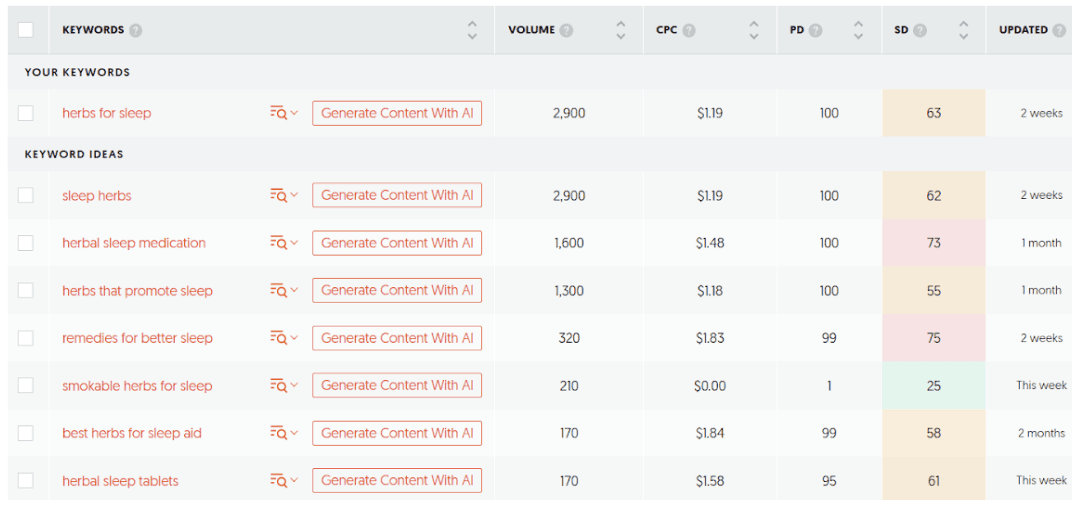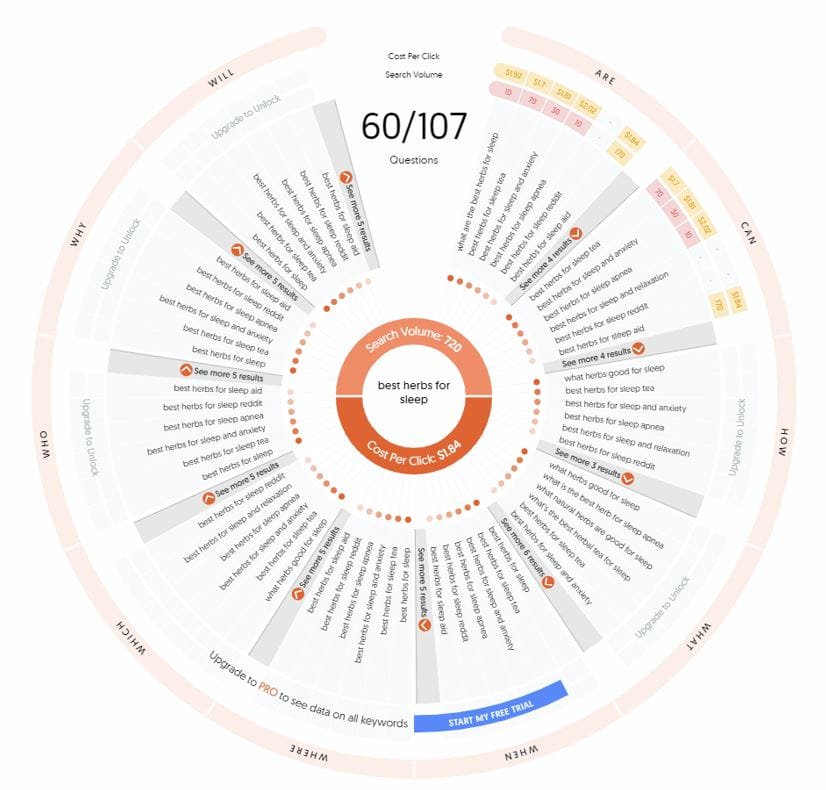Agencies serve an astounding number of clients with content creation, which means needing an endless supply of blog post ideas. The Spaghetti Method is one option—throw ideas at a wall and see what sticks. But there are better ways to approach blog topic creation, especially when you involve data that aligns with your clients’ goals.
Let’s review seven methods we use at Content Pros to help our agency clients come up with content ideas and topics that get results.
1. The Keyword-First Approach
There are several ways to drive traffic to a blog post: email newsletters, social media, or guest posting, for example. But many companies rely on organic traffic for their blogs to be discovered by non-customers, which is why they value SEO.
To help your clients’ blogs rank higher in search results, we suggest building your topics around keywords that have a high search volume and low competition. Keyword research tools (e.g., Ahrefs, UberSuggest) make this easy.
Here’s how you can do keyword research for your clients that inspire new blog topics:
- Go to UberSuggest and open Keyword Ideas.
- Type in 1-3 keywords related to your client’s business.
- Review the list of suggested keyword ideas. Look for those with a search difficulty of 30 or less and a search volume of 50 or more (this is ideal).
- Type your chosen keyword into Google to see how others have approached the topic.
- Use your keyword tool to find related keywords to your selected keyword.
For example, let’s say your client owns an online supplement store and wants to increase sales of a few specific supplements. In this case, we typed in “herbs for sleep.” Here’s part of the list:

Based on the data, the keyword “smokable herbs for sleep” might be a great keyword to target. It has low competition and 210 monthly searches. It’s also a keyword that might have gone overlooked without going through this process.
2. Use Answer the Public
Google’s Helpful Content update in September 2023 cracked down on spammy, algorithm-first content in favor of articles and videos that provide useful information.
To learn more about what Google’s definition of “useful” is, tools like Answer the Public can shine a light on what people want to know.
Answer the Public compiles search data to see what questions people are asking online. You can filter your results between Google, Bing, and YouTube to better target your results.
Using the same example, here’s a sample of what Answer the Public gave us:

At first glance, possible topics could be “best herbs for sleep tea” or “best herbs for sleep apnea,” for example.
Based on what people are asking, you can create relevant blog content that answers their questions. Compare your content to what’s already ranking well on the same topic so you can make your content more thorough and valuable.
3. Seek Support from Customer Service
Tools like Answer the Public work well for general questions and information about a topic. But if you want to go more granular, recruit help from your clients’ customer service and sales teams. They’re the front lines of support issues and customer inquiries and can provide company-specific intel on what customers need and want to know.
4. Check out Your Competitors
Your clients’ competitors can be great sources of inspiration when coming up with topics to fill a content calendar for your clients. While you shouldn’t copy them outright, you can see what conversations they’re starting and how you can put a unique spin on things.
The other benefit of competitor recon is using data tools to see if a topic is worth exploring. Here’s how to do this using UberSuggest:
- Log in to UberSuggest and go to Traffic Estimation.
- Copy and paste a competitor blog URL into the search bar.
- Click Search.
Now you have a list of organic keywords the article is ranking for, the number of backlinks to the article, and how much monthly traffic the article receives. If the article is more than a few weeks old, you can also see traffic trends over time to track its popularity.
Validating your competitors’ blog topics is a great way to preserve your resources. You’ll have a better idea of how a blog topic will perform before you invest time and effort.
5. Get Inspired by Google Alerts
Blogging is a never-ending task for agencies, which is why you should brainstorm topics on an ongoing basis. One easy (and data-driven) way to do this is to create Google Alerts for keywords related to your clients’ industries, products, and services.
Google will send you a daily digest of new content published using those keywords. You’ll get an instant view of relevant conversations and who’s publishing them, which can inspire the topics you pitch to your clients.
6. Use Social Listening to Go Pre-Viral
Ever wonder how some topics seem to go viral overnight? Social listening tools help to fuel those conversations. These tools detect trends and patterns to give publishers a heads-up about what people are interested in. This way, they can join the conversation before it becomes too noisy.
Examples of social listening tools include:
- Buzzsumo
- Meltwater
- Mention
- Sprout Social
- Talkwalker
- Hootsuite
Agencies can use social listening tools to track keywords and conversations on their clients’ behalf. Learning more about trending topics can inspire countless new blog post ideas that are most likely to make an impact.
7. Use Keyword Expansion Techniques
The best way to know what Google likes is to go straight to the source. Google provides tons of “hints” about what people are searching for, even if you don’t have a keyword tool or social listening tool.
Google’s Autocomplete is a great place to start. Input part of a keyword and see what Google “guesses” you’re going to type, like this:

Our fictional herb supplement store could start typing “herbs for…” and see six possible blog post ideas that other people have already searched for.
Another option is to check the “People Also Ask” section of Google’s SERPs. Type in your query, then see what similar questions people have searched for. Based on a search for “best herbs for sleep,” we see the following questions:

One of these could be a standalone blog post or they could be questions to include in a pillar post, for example.
We refer to these methods as “keyword expansion techniques,” where we start with a basic keyword and dig deeper into how people are searching for related content. These techniques work well because they use Google’s data to show what real people want to know.
Lean on Our Expertise for Blog Topic Creation
Whether you need help applying the above blog topic creation methods or simply want to fast-track your clients’ results, Content Pros can help. Contact us today and let us help you craft a winning strategy for your agency’s clients.
Try our free Topic Generator for a list of blog post ideas in seconds!

